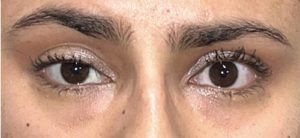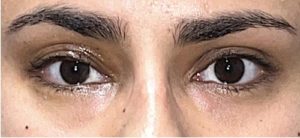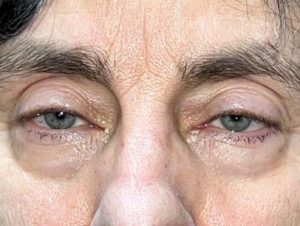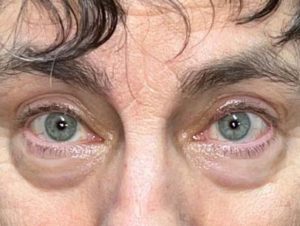Ptosis is the medical term for drooping. Blepharoptosis refers to drooping of the upper eyelid margin. This causes the eye to appear sleepy or lazy. This can cause others to misjudge your intelligence, level of wakefulness, alertness, interest in conversing, and beauty. This can be congenital at birth and affect visual development, and cause a deviation of where the eye is pointing. Rarely, ptosis can be an inherited condition seen across families.
What Are The Causes of Ptosis?
Eyelid ptosis is anatomically caused by a weakening of the eyelid levator muscle or disruption of the tendon connected to it. There are many causes for this condition, including: disease, injury, congenital birth defects, previous eye surgery/trauma, eyelid rubbing (e.g., allergies, habit), contact lens wear, and aging changes. Most causes of ptosis do not improve with time and can cause significant visual issues.
Patients with ptosis often notice trouble with reading, driving (e.g., missing red lights), headaches, and sometimes accidental head trauma (e.g., bumping into cabinets). Some patients will adopt a head tilt (“chin lift”) position to compensate for droopy eyelids. Others will also chronically and subconsciously use their forehead muscles (the frontalis) in an attempt to pull the eyebrows and eyelids upward to see better. This can lead to frontal area headaches and fatigue towards the end of the day after using the forehead muscles all day long to compensate. It can also them to appear to have a displeasing “surprised” look.
Before and After Pictures
Ptosis
Hidden Incision Ptosis Repair
Are There Other Areas of Ptosis Around the Eyes?
Ptosis can refer to almost any form of tissue descent, and it also may involve the forehead where it is described as “brow ptosis.” This can cause the brow tissues to fall below their normal positions and cause “bunching” of the upper eyelid skin and visual problems. Oftentimes, brow ptosis can be coexistent with excess upper eyelid skin. At other times, a patient may be seeking or incorrectly referred by their doctor for an “eye” lift, but their actual problem is brow ptosis. This means that they won’t get the improvement they are seeking by an upper eyelid lift (blepharoplasty) alone.
How Can Ptosis Be Treated?
Dr. Burroughs frequently performs simultaneous brow lifting, blepharoptosis (“ptosis”) repair, and blepharoplasty surgery. In fact, he has published numerous surgical textbook chapters on these techniques. Unfortunately, some insurances (e.g., Medicare and some commercial insurances) won’t cover each of these problems simultaneously, but Dr. Burroughs does his best when they are causing visual interference problems to fix each of the issue together in one surgery. The mid-face and lower eyelid can also descend with age and cause a patient to look tired, sad, or “worn out.” This can also compromise eye health because, if there is tension pulling the lower eyelid downward, it can lead to dry eyes, incomplete eye closure, and eye redness/irritation. Some patients need these issues addressed medically to improve eye comfort and vision, especially if an upper eyelid lift blepharoplasty or ptosis repair is done since this will increase the ocular surface area of exposure to air and drying out.
Why Should You Have Dr. Burroughs Perform Your Eyelid Ptosis Surgery?
Beauty By Burroughs
- Experience matters: Dr. Burroughs is amongst the most well known and experienced eyelid surgeons in Colorado
- Highly (fellowship) trained by an oculofacial plastic surgery pioneer
- Member of the prestigious American Society of Ophthalmic Plastic Surgeons and board-certified ophthalmic surgeon
- Master surgeon chosen by other surgeons with 20+ years experience
- Local Reputation: Consistent Peer-Selected Top Doc in Colorado Springs
- National Reputation: Multi-Year Peer-Selected to Best Doctors
- Innovator & Invited speaker at national and international symposia
- Thought leader for advancing surgical techniques and outcomes
- Recognized ptosis expertise: author of textbook chapter on ptosis surgery
- Recognized Eyelid Expertise: 100 publications and textbook chapters for cosmetic eyelid and facial surgery and rejuvenative techniques
- Collaborator and friend of other nationally respected surgeons including the cosmetic epicenters of Beverly Hills and New York
- Unique adjunctive treatments provided, many complimentarily, at his in-office medical spa not available at most other plastic surgeons
- 1st in Colorado to speed healing, reduce bruising with LidLift goggles
- 1st to bring TXA for eyelid surgery in Colorado to decrease surgical bleeding, decrease postop bleeding, and faster healing
- Compassionate, Results-Focused, & Experience-Based Practice
- Aesthetic awareness & ability to obtain ideal eyelid contours
- Emphasis on listening to patients to give natural appearing results
- Revision and Reconstructive Eyelid Expert
- Ethical surgeon with recommendation integrity for safety first
- Patient-focused with a servant-mindedness calling as a surgeon
Who Treats Ptosis?
The difficulty of eyelid ptosis surgery was the genesis for the oculoplastic subspecialty founded by pioneer ophthalmic surgeons. Plastic surgeons struggled, prior to 50 years ago, to obtain consistent and safe surgical results. A successful result is comprised of a lift that is symmetric, optimally lifted, and with aesthetic contours. Oculofacial plastic surgeons are the most experienced and best trained surgeons to perform eyelid ptosis surgery. They obtain the highest success results with the lowest reoperative rates. Dr. Burroughs’ revision rate for blepharoptosis surgery is under 5%, vs. up to 25% by non-oculoplastic trained surgeons, for primary cases.
He is referred many revision cases from other surgeons because of his high results. In the rare circumstance that Dr. Burroughs has to perform a revision of one of his cases this can be done in his office operating room without extensive anesthesia. Some general ophthalmologists perform ptosis surgery, but almost always under insurance with an “insurance” result. Other facial and plastic surgeons perform ptosis surgery but with less experience, and often miss ptosis correction in conjunction with their other cosmetic eyelid surgery resulting in a suboptimal result necessitating a second surgery. An additional benefit to an aesthetic eyelid surgeon is that an oculoplastic surgeon can and should analyze the ocular surface health before any eyelid surgery in the case of conservative surgery being required to protect eye comfort and health in the situations of corneal hypoesthesia or severe dry eye.
How is Ptosis Surgery Performed?
Ptosis surgery can be performed in the office with local anesthesia with or without oral or IV sedation. Dissolving sutures may be used for patient postoperative comfort. Ptosis surgery in isolation can take as little as 10 minutes to perform by very experienced surgeons like Dr. Burroughs.
Dr. Burroughs most commonly performs ptosis surgery with an invisible (hidden) incision under (inside) the eyelid because of its high predictability and excellent aesthetic contour result. The internal approach offers the highest intraoperative comfort, and is performed without needing patient cooperation during the surgery.
Dr. Burroughs was also trained by a world-renowned oculoplastic surgeon and pioneer of the external approach through an upper eyelid incision that can be quite small, but is more commonly done through an upper blepharoplasty incision to also removed unwanted excess skin. Oftentimes for the best result, some upper skin needs to be removed to avoid an “accordion” effect of the skin once the eye becomes more open. This accordion or unmasking of excess upper eyelid skin is often worsened by descent of the eyebrows following successful surgery because the frontalis (brow elevating muscle) compensation is no longer needed. Patients need to cooperate during an external repair by looking up and down to ensure the levator muscle and/or tendon are optimally tightened and the desired aesthetic contour is obtained.
Sometimes if their extreme weakness or acquired paralysis of the levator (lifting eyelid muscle) then a frontalis suspension is needed usually with a suture method connecting the frontalis muscle under the skin to the tarsus along the upper eyelid margin.
How Much Does Ptosis Surgery Cost?
Insurance may cover ptosis surgery, but very strict photographic, severe visual symptom issues, and visual field criteria must be met. The cosmetic cost range varies depending upon it if is needed unilaterally or bilaterally in isolation to other surgical eyelid procedures. It is often and best performed in conjunction with other cosmetic eyelid surgery.
What is Healing Like From Eyelid Ptosis Surgery?
Best results can rarely take a few months for the final result, but more often the success is seen within a few days to a few weeks depending upon swelling. You will usually only experience minimal discomfort. Bruising and swelling is reduced by the use of LidLift goggles uniquely designed and first brought to Colorado by Dr. Burroughs. The Springs Aesthetics medical spa that Dr. Burroughs is the medical director for can complement the results, and speed healing by offering treatments to speed swelling and bruising resolution.
Is Eyelid Ptosis Surgery Safe?
Ptosis surgery is definitely safe when performed by experienced, dedicated, and skilled eyelid plastic surgeons like Dr. Burroughs. Mindfulness of the ocular surface is needed during the passage of a knife, electrical needle, laser, or suture needles. Ophthalmic surgeons spent extensive residency training literally saving eyes and eyesight through eye surgery and other procedures. Ophthalmic surgeons are the most ocular anatomy aware surgeons amongst all specialties, and are extremely comfortable performing delicate and at times extensive surgeries on or around the eyes.
For more than 20 years, Dr. John Burroughs has helped men, women, and children in Texas, Florida, Utah, and Colorado. He is referred from within Colorado Springs and areas including South Denver, Castle Rock, Pueblo, and areas outside of Colorado, and even rarely internationally, by providing exceptional care in plastic surgery and eyelid surgery. At his practice, he also offers medical spa treatments performed by aestheticians and physician extenders (nurses), which complement and can speed healing. To learn more about blepharoplasty eyelid surgery, contact us today to schedule a consultation.




